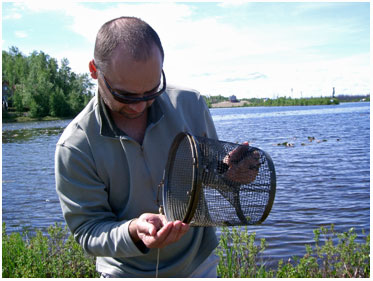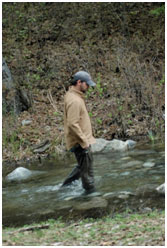Richard King, Ph.D.
 My interests are varied and include ecology, issues in biodiversity conservation (particularly marine), and as related topics habitat degradation, invasive species, and climate change. Generally I’m interested in how organisms invade new habitats, adapt to changing environments, and how species distributions are impacted via anthropogenic causes. For my dissertation I studied how marine and anadromous threespine stickleback are readily able to invade and remain in freshwater streams and lakes and subsequently the rapid evolution within those newly invaded habitats. I also studied how key life historical and morphological traits are shaped by the environment (plasticity).
My interests are varied and include ecology, issues in biodiversity conservation (particularly marine), and as related topics habitat degradation, invasive species, and climate change. Generally I’m interested in how organisms invade new habitats, adapt to changing environments, and how species distributions are impacted via anthropogenic causes. For my dissertation I studied how marine and anadromous threespine stickleback are readily able to invade and remain in freshwater streams and lakes and subsequently the rapid evolution within those newly invaded habitats. I also studied how key life historical and morphological traits are shaped by the environment (plasticity).
More recently my interests have shifted specifically to British Columbia Canada populations of freshwater/oceanic species pairs of threespine stickleback and watershed scale conservation efforts. Working under a National Geographic grant to the Foster/Baker lab, our group located several undocumented populations including one over 600 meters in elevation, well over 300 meter higher than any other known stickleback population in coastal BC. We’ve also located several freshwater/oceanic species pairs and numerous freshwater populations that are polymorphic for armor structures. Outside of academia my work centers on control of invasive species as a consultant, modeling the drift and dissipation of aquatic herbicides when they are used for aquatic plant control, and developing novel lake and land management programs that can be supported by local communities utilizing volunteer effort.
‘Applied’ Ecology
 I am interested in the transfer of scientific knowledge to solving ecological problems outside of the academic arena. Endemic species are particularly interesting from a conservation perspective. As an undergraduate I worked on an EIS exploring the impact of hydropower generation on population sizes and distributions of endemic Hawai’ian gobies and native freshwater shrimp on the Big Island of Hawai’i. Since then my interests in ‘hands on’ conservation work has only increased. More recently, I have focused on local issues with an emphasis on invasive, non-native freshwater plants in Adirondack Mountain lakes (and their impact on native species). Future work will include invasive marine organisms and possible control/eradication techniques in geographically wide-scale invasions. Coral reefs and intertidal communities are two of the most biologically diverse ecosystems in marine environments. However, warming trends and globalized economies (transport of goods) has led to a proliferation of species introductions and subsequent invasions. Far too often the displacement or extirpation of native species quickly follows. While many conclude little to nothing can be done in such situations, we have scarcely even begun to explore the ecological interactions of the invaders in their new habitats and possible solutions to these problems.
I am interested in the transfer of scientific knowledge to solving ecological problems outside of the academic arena. Endemic species are particularly interesting from a conservation perspective. As an undergraduate I worked on an EIS exploring the impact of hydropower generation on population sizes and distributions of endemic Hawai’ian gobies and native freshwater shrimp on the Big Island of Hawai’i. Since then my interests in ‘hands on’ conservation work has only increased. More recently, I have focused on local issues with an emphasis on invasive, non-native freshwater plants in Adirondack Mountain lakes (and their impact on native species). Future work will include invasive marine organisms and possible control/eradication techniques in geographically wide-scale invasions. Coral reefs and intertidal communities are two of the most biologically diverse ecosystems in marine environments. However, warming trends and globalized economies (transport of goods) has led to a proliferation of species introductions and subsequent invasions. Far too often the displacement or extirpation of native species quickly follows. While many conclude little to nothing can be done in such situations, we have scarcely even begun to explore the ecological interactions of the invaders in their new habitats and possible solutions to these problems.

Curriculum Vitae (long form) 2016
Publications
Heins, D.C., J.A. Baker, R.W. King, K. Lahti. (1995). Evaluation of ovum fixation and storage in three-spined stickleback. Journal of Fish Biology. 47, 923-925.
Cameron, S.A., J.B. Whitfield, C.L. Huslander, W.A. Cresko, S.B. Isenberg, R.W. King. (1996). Nesting Biology and Foraging Patterns of the Solitary Bee Melissodes rustica (Hymenoptera: Apidae) in Northwest Arkansas. Kansas Journal of Entomology. 69,3
Baker, J.A., S.A. Foster, D.C. Heins, M.A. Bell and R.W. King. 1998. Variation in female life-history traits among Alaskan populations of the threespine stickleback, Gasterosteus aculeatus, L. (Pisces: Gasterosteidae). Biological Journal of the Linnean Society 63:141-159.
Baker, J.A., D.C. Heins, S.A. Foster and R.W. King. 2008. An overview of life-history variation in female threespine stickleback. Behaviour 145:579-602.
Baker, J.A., D.C. Heins, R.W. King and S.A. Foster. 2011. Rapid shifts in multiple life-history traits in a population of threespine stickleback. Journal of Evolutionary Biology 24:863-870.
Baker, J.A., L.A. Ackein, D.C. Heins, R.W. King and S.A. Foster. 2013. The implications of pelvic reduction in threespine stickleback for long-term persistence of populations. In: A.P. Hendry and C.L. Peichel (eds.), Stickleback Behaviour and Evolution: Contributions from the Seventh International Conference. Evolutionary Ecology Research 15:313-330.
Baker, J.A., M.A. Wund, D.C. Heins, R.W. King, M.L. Reyes & S.A. Foster. 2015. Life-history plasticity in female threespine stickleback. Heredity. 115: 322-334.
Baker, J.A., D.C. Heins, K.R. O’Brien and R.W. King. (in prep.) Diversification of egg size and clutch size in Alaskan threespine stickleback.
Baker, J.A., D. Navon and R.W. King. (in prep.) Life-history diversification in threespine stickleback from coastal southern British Columbia.
Baker, J.A. and R.W. King. (in prep.) The Native Ichthyofauna of Hawaii’s Largest River, the Wailuku River, Hawaii Island, with comments on distributional limitations. To be submitted to Pacific Science.
King, R.W., J.A. Baker, M.A. Wund and S.A. Foster. (in prep) Dual ancestral flexible stems in an adaptive radiation? To be submitted to The American Naturalist.
King, R.W., & J.A. Baker, (in prep.) Life history variation in marine and anadromous threespine stickleback in Alaska. To be submitted to Can. J. of Fish. and Aqua. Sci..
King, R.W., J.A. Baker, and S.A. Foster (in prep.) Evolution of life histories in oceanic threespine stickleback. To be submitted to Evolution.
Courses Taught
Lecturer, Clark University: Evolution, Ecology, Conservation Biology, Marine Biology, Why Climate Change Matters, Topics in Marine Biology, Biodiversity
Directed Studies courses: Invasion Biology, Conservation Biogeography
Visiting Assistant Professor, University of Connecticut, Storrs: Biology, Ecology, Modern Topics in Biology, Field Methods in Ecology, Honors Seminar;
Writing Instructor for Ecology, Evolution.
Teaching Assistant, Clark University: Biology, Evolution, Cell Biology, Ecosystems Ecology, General Ecology